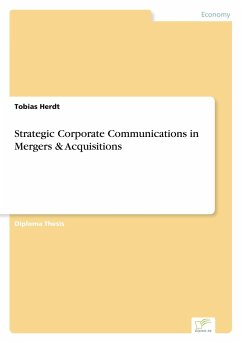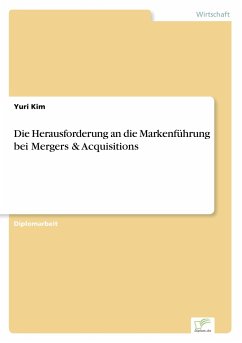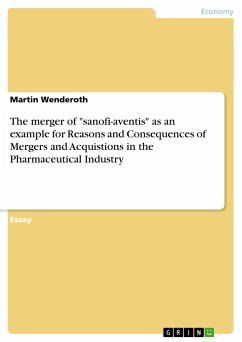Diploma Thesis from the year 2003 in the subject Business economics - Marketing, Corporate Communication, CRM, Market Research, Social Media, grade: 1,0, University of Applied Sciences Rotterdam (Wirtschaft), language: English, abstract: Inhaltsangabe:Summary:
M&A transactions and corporate change are frequent occurrences in the globalized economies of today (c.f. section External growth and communication as global trends , page 1). On a global scale, led by the U.S., the European Union and Germany, M&A transactions have clearly become a global mega trend.
Despite their growing popularity, M&A transactions often fail to produce the desired outcomes (c.f. section M&A Failure and Corporate Communications , page 5). This is partly due to poor M&A communication.
The study at hand has several aims:
To discuss the significance of M&A communication for the overall success of a transaction
To establish the general determinants for the quality of M&A communication The key success factors
To examine the individual determinants The factors determining the quantitative and qualitative deployment of M&A communication and its adjustment to the varying preconditions of different transactions
Secondary as well as primary data led to the conclusion that M&A communication is of high significance to the success of an M&A transaction and can impact its results. Even if M&A communication can never be the single most important factor, determining merger success or failure, corporations acknowledging the significance of best-practice M&A communication have a higher M&A success probability and avoid opportunity costs.
As described in more detail in section The significance of M&A communication for the overall success of a transaction , page 51, M&A communication derives its significance from the functions it fulfills. In the course of the interviews, those functions could be identified as reputation function, manipulation function, information function, acceptance function, action function, security function, and motivation function. In the context of post-merger integration communication, especially the possibility to decrease employees level of change resistance, uncertainty, frustration and demotivation is of particular value to transaction success.
Even if communication per-se is a qualitative, not a quantitative factor, the study at hand concludes that there are ways to assess and evaluate communication success. If communication is ranked against what communication can possibly accomplish, communication success can be defined and measured (c.f. section The assessment of M&A communication success , page 57).
As communication is significant to M&A transaction success and as communication success is measurable, the following part of the study focuses on general determinants and indicators, determining M&A communication success.
It is found that there are five key-success factors, essentially determining M&A communication success (c.f. section The general determinants: Key success factors of M&A communication , page 63):
Communication controlling
Communication consistency
Strong argumentation construct
Communication support
Communication integration and communication teams
Those factors are of utmost importance to communication success but are independent from the structure of a given transaction. It is thus necessary to turn to a second group of factors, the individual success factors, which determine how a communication strategy has to be adjusted to the preconditions of a particular transaction in order to meet the requirements of the key success factors ( c.f. section The individual determinants: Determinants fort he quantitative and qualitative deployment of M&A communication , page 71).
With regard to the outcom...
M&A transactions and corporate change are frequent occurrences in the globalized economies of today (c.f. section External growth and communication as global trends , page 1). On a global scale, led by the U.S., the European Union and Germany, M&A transactions have clearly become a global mega trend.
Despite their growing popularity, M&A transactions often fail to produce the desired outcomes (c.f. section M&A Failure and Corporate Communications , page 5). This is partly due to poor M&A communication.
The study at hand has several aims:
To discuss the significance of M&A communication for the overall success of a transaction
To establish the general determinants for the quality of M&A communication The key success factors
To examine the individual determinants The factors determining the quantitative and qualitative deployment of M&A communication and its adjustment to the varying preconditions of different transactions
Secondary as well as primary data led to the conclusion that M&A communication is of high significance to the success of an M&A transaction and can impact its results. Even if M&A communication can never be the single most important factor, determining merger success or failure, corporations acknowledging the significance of best-practice M&A communication have a higher M&A success probability and avoid opportunity costs.
As described in more detail in section The significance of M&A communication for the overall success of a transaction , page 51, M&A communication derives its significance from the functions it fulfills. In the course of the interviews, those functions could be identified as reputation function, manipulation function, information function, acceptance function, action function, security function, and motivation function. In the context of post-merger integration communication, especially the possibility to decrease employees level of change resistance, uncertainty, frustration and demotivation is of particular value to transaction success.
Even if communication per-se is a qualitative, not a quantitative factor, the study at hand concludes that there are ways to assess and evaluate communication success. If communication is ranked against what communication can possibly accomplish, communication success can be defined and measured (c.f. section The assessment of M&A communication success , page 57).
As communication is significant to M&A transaction success and as communication success is measurable, the following part of the study focuses on general determinants and indicators, determining M&A communication success.
It is found that there are five key-success factors, essentially determining M&A communication success (c.f. section The general determinants: Key success factors of M&A communication , page 63):
Communication controlling
Communication consistency
Strong argumentation construct
Communication support
Communication integration and communication teams
Those factors are of utmost importance to communication success but are independent from the structure of a given transaction. It is thus necessary to turn to a second group of factors, the individual success factors, which determine how a communication strategy has to be adjusted to the preconditions of a particular transaction in order to meet the requirements of the key success factors ( c.f. section The individual determinants: Determinants fort he quantitative and qualitative deployment of M&A communication , page 71).
With regard to the outcom...








